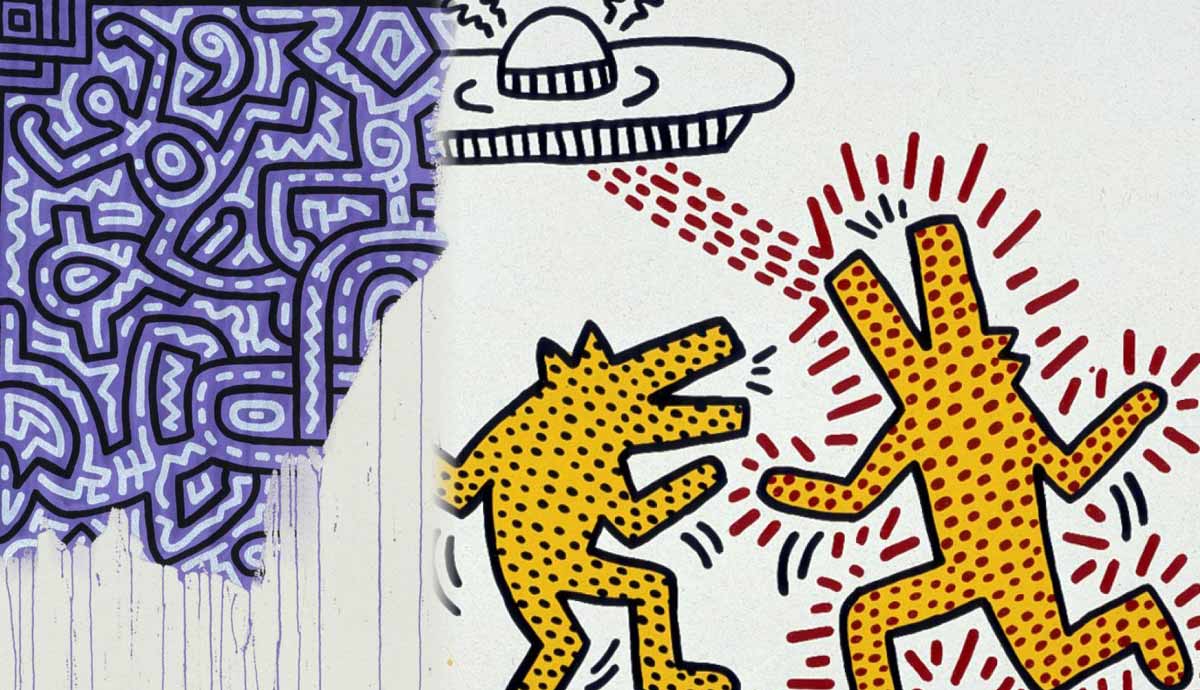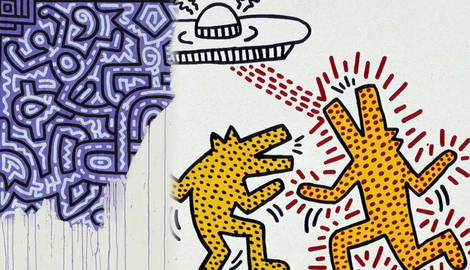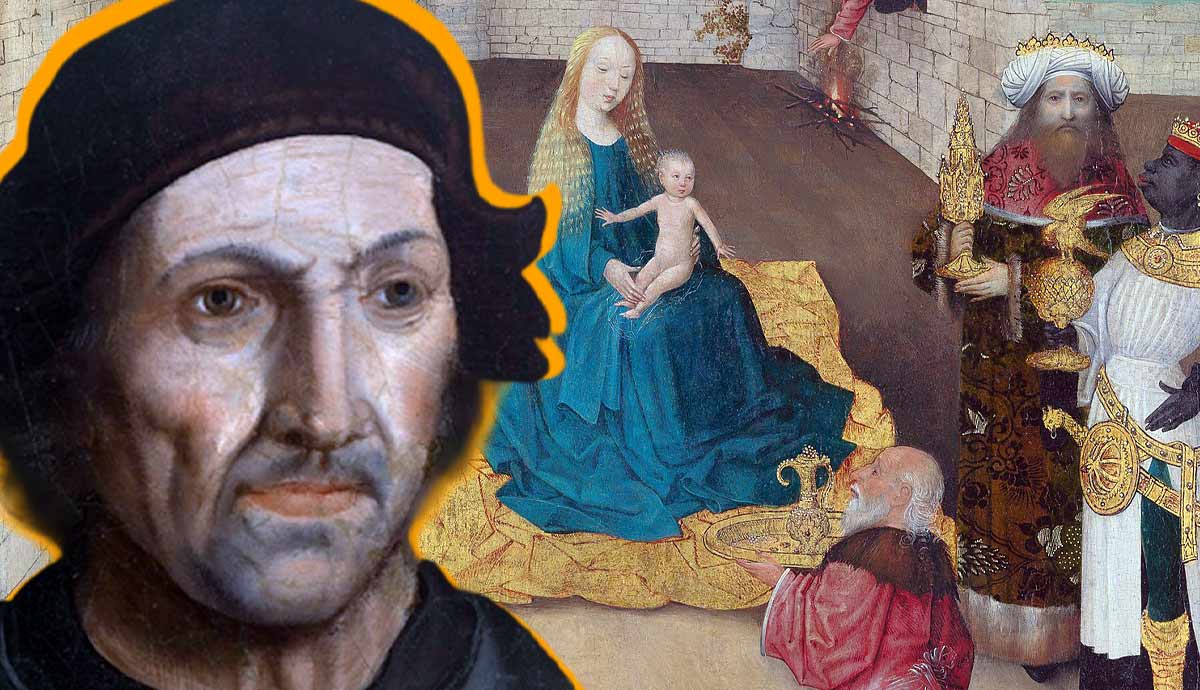
In 1989, the American Pop artist Keith Haring created a painting that he deliberately left unfinished. It was a cry for help and tragic evidence of the AIDS epidemic that not many people cared about except for those who were dying from it. Several months later, the artist himself passed away from AIDS-related complications, leaving this work as the last reminder of his life. In 2023, a social media user completed the painting using artificial intelligence, framing it as a heartfelt tribute to the artist.
Who Was Keith Haring?

Among many remarkable artists of the American 1980s, Keith Haring remains one of the most recognizable and influential ones. Haring was a member of the artistic generation who sought to dismantle the barrier between high and low culture, expensive gallery art and images found in the city streets. Like many other children in the USA, he was exposed to pop culture that included comic books and advertisements from an early age. This influenced his artistic style in numerous ways. He initially started his training as a commercial artist but dropped out of art school after just two semesters. Early on in his career, Haring recognized the importance of people interacting with his art and regarded the commercial domain of art as too restrictive.

Haring started to engage with his audience by leaving white chalk drawings on subway walls, with passengers often initiating conversations on his images. Gradually, he moved from chalk to graffiti, creating more complex and multi-colored compositions. His painting style reminded people of childish stick figures intertwined to form a kind of tapestry, with meanings, questions, and associations coded in between. From an unknown street artist, he soon turned into an almost-celebrity, befriending Jean-Michel Basquiat and Andy Warhol. Ironically, commercial art that he initially avoided came to him later, with several famous brands like Swatch and Absolut commissioning designs from him. In 1983, Haring even created a collection with Vivienne Westwood, designing prints for her garments.
Activism

Yet the crucial part of Keith Haring’s oeuvre was his political activism. The simple language of Haring’s art made his messages accessible to the public and understandable on an almost intuitive level. He spoke on the wrongdoings of Richard Nixon, unemployment, drug abuse, homophobia, and abuse of power. Yet the central topic of his activist art was the ongoing AIDS crisis. The disease that killed millions went almost unnoticed. The talk about it was almost silenced in the press and the disease was labeled as a sort of punishment for gays, sex workers, and drug addicts. A homosexual man himself, Haring witnessed dozens of his friends waste away, dying in the arms of their loved ones. He advocated for safe sex, healthcare, and AIDS awareness, creating powerful and heartbreaking images. Haring would become yet another life on the list of those affected by the disease.
The Unfinished Painting

In 1988, Keith Haring was diagnosed with AIDS. He was at the height of his career at the time and realized he did not have much time left. He dedicated himself to activist projects, painting murals in both Europe and the USA and appearing in activist documentaries. In his notes from the period of his initial diagnosis, he wrote that he had only been making art for ten years. Noticing his artistic evolution, he imagined how things could turn out if he were to live another several decades.
One of the last works Keith Haring ever painted was the Unfinished Painting from 1989. The artist understood he would not be able to complete the work, and intentionally left three-quarters of it blank, with paint dripping from the only finished corner. The painting, relatively unknown in comparison to other Haring’s works, remains a painful and striking reminder of lives lost and deeds unfinished. Its astonishing simplicity makes the emotional effect even more devastating, provoking anger and grief.
AI Enthusiast Versus Art Historians

In January 2024, a user of the social media platform X (formerly known as Twitter) under the nickname Donnel published an image of Haring’s work, altered with artificial intelligence to fill in the blank space. The user commented that now, with the use of AI, we could complete what the artist was not able to finish. After posting the image, the user did not make any further comments, leaving their intentions unclear to the media and other users.
The public reaction was remarkable in its intensity. While some users (mostly those who did not know the backstory of the painting) were rather uplifted by the image, the majority called the decision disrespectful. People were genuinely offended by the erasure of the core idea of the work. Apart from Keith Haring’s artistic intention, this completion ignored the histories of thousands of people of Haring’s generation and beyond who lost their lives to the disease.

Not only did the so-called restoration anger art lovers and experts by ruining the message behind the work, but the AI also did not do its job properly. The algorithm failed to understand the logic behind Haring’s patterns and simply filled the blank space with similarly shaped lines instead of human figures. Even those users who did not recognize ethical issues around the whole act noticed the inconsistency in quality and design.
Some social media users believe that the controversy behind the act was completely intentional and relied on the updated algorithms of X. Since the summer of 2023, the platform, currently controlled by the controversial billionaire Elon Musk, has offered to share ad revenue with a selected group of users. To qualify for it, a user has to pay for an upgraded X membership and gain a certain level of user engagement with their posts. This led to an unprecedented rise in hate speech, provocation and controversial content aimed at baiting the wider audience into interacting with the author of the original post. Thus, the completed AI painting may not be related to the domain of art at all. It could simply be an instrument, and a rather successful one, used by the author to gain prominence.
AI Ethics and Keith Haring’s Work

The application of AI for the purposes of art history and restoration remains a highly controversial topic that divides the art world. In the current state of affairs, the overwhelming majority of art experts agree that the application of AI algorithms causes much more harm than good. Just like with the recent case of AI-led colorization of the lost works by Gustav Klimt, the final result was neither worth the technological effort nor the attention it received in the media.
The case of Keith Haring’s work raises more ethical concerns, ones related to artistic intent and its posthumous interpretation. Haring deliberately left the painting unfinished, using the empty space as a reminder of the many lives that were forever lost, including his own. The half-hearted attempt to fill the gaps with artificially created drawings only made things worse. It seemed like the whole project was crudely covering the severity of the issue behind the original work.

While some users accused the author of AI-generated work of digital vandalism, others praised their iconoclastic decision to attack the popular and universally acclaimed element of the art world. Some chose to interpret it as an attack, not on Haring’s legacy, but rather on the concept of the sacredness of art and artists who were considered geniuses. However, judging by the overwhelming majority of social media posts and media publications, the public demonstration of one’s lack of empathy is falling out of fashion and is no longer seen as a suitable form of protest.










